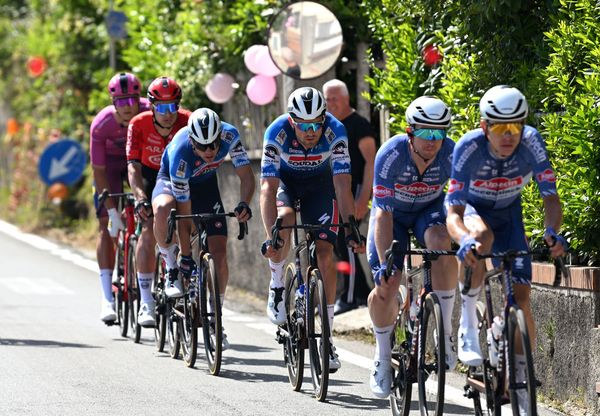Paris-Roubaix: 8 things we learnt from the cobbled Classics climax
After an enthralling weekend of race action we share our key conclusions from this year's 'Hell of the North'
GCN
The GCN team
© Getty Images
Two world champions; two Paris-Roubaix winners
By Matilda Price and George Poole
Paris-Roubaix marked the end of the cobbled Classics at the weekend, with Lotte Kopecky (SD Worx-Protime) and Mathieu van der Poel (Alpecin-Deceuninck) triumphing in iconic fashion whilst wearing their rainbow jerseys as world champions.
There may be a few cobbles to come in the remaining smaller races, but the women's and men's Paris-Roubaix from Saturday and Sunday truly marked the crescendo of the much-loved spring campaign.
The GCN web team were on the ground in France across the weekend. Talking to riders and seeing the races unfold has left us with the following eight conclusions from Paris-Roubaix 2024:
1. There’s a cobblestone at the end of the rainbow
When people talk about Paris-Roubaix, they often talk about the chaos and unpredictability. It’s a race you can’t plan; where things often go wrong, where the underdogs can win. That makes it hard for the riders who go into this race as a favourite. They need absolutely everything to go right to be able to win, and we’re told that perfection is rare on the Roubaix cobbles. But not if you’re Lotte Kopecky and Mathieu van der Poel.
Read more: Up close with the Paris-Roubaix cobbles
The pair went into their respective races this weekend as overwhelming favourites, both with significant pressure to win – Van der Poel to defend his title and complete the Flanders-Roubaix double, and Kopecky to avenge her Flanders result and take a first Roubaix victory for SD Worx-Protime – and, most strikingly, both wearing the rainbow jersey. The idea of not just one but both world champions pulling off the feat of winning seemed unlikely give the nature of Paris-Roubaix. And yet despite the odds it happened. A double rainbow in Roubaix; the two greatest riders right now winning the hardest race on the calendar. It was cycling perfection, and a sight to behold in a race that often tears up the script.
The way they claimed victory couldn’t have been more different. Van der Poel winning from a 60km solo, and Kopecky taking victory in a group sprint in the velodrome. Even so, the essence was the same: two unbelievably strong riders delivered by strong, dedicated teams to momentous victories. Van der Poel and Kopecky know how to take all the pressure and expectation and turn it into a huge result, proving each time why they’re the champions of the world.
2. A Monument podium means more than we might think
When you’re watching elite athletes who compete to win, and who have tasted victory before, it can be easy to assume that anything besides the top step of the podium would be a disappointment. Whilst all the key riders in the men’s and women’s Paris-Roubaix wanted to win, watching the riders roll in from both races reminded us that in a Monument, especially one as hard as this, a podium can be just as satisfying as a win.
At the women’s finish, one of the defining images was when Pfeiffer Georgi (dsm-firmenich PostNL) realised she’d come third, rather than fourth, and the joy and elation that quickly spread over her tired face. It was special and emotional, and she called the result “like a win”, clearly overjoyed with what she had achieved. It was a similar story for Mads Pedersen (Lidl-Trek), a more prolific winner than Georgi perhaps, but the Dane still found satisfaction in his third place on Sunday, not reaching for excuses, accepting his shortcomings and being happy on a Monument podium.
3. Lidl-Trek can’t always beat the favourites, but they are a very strong team
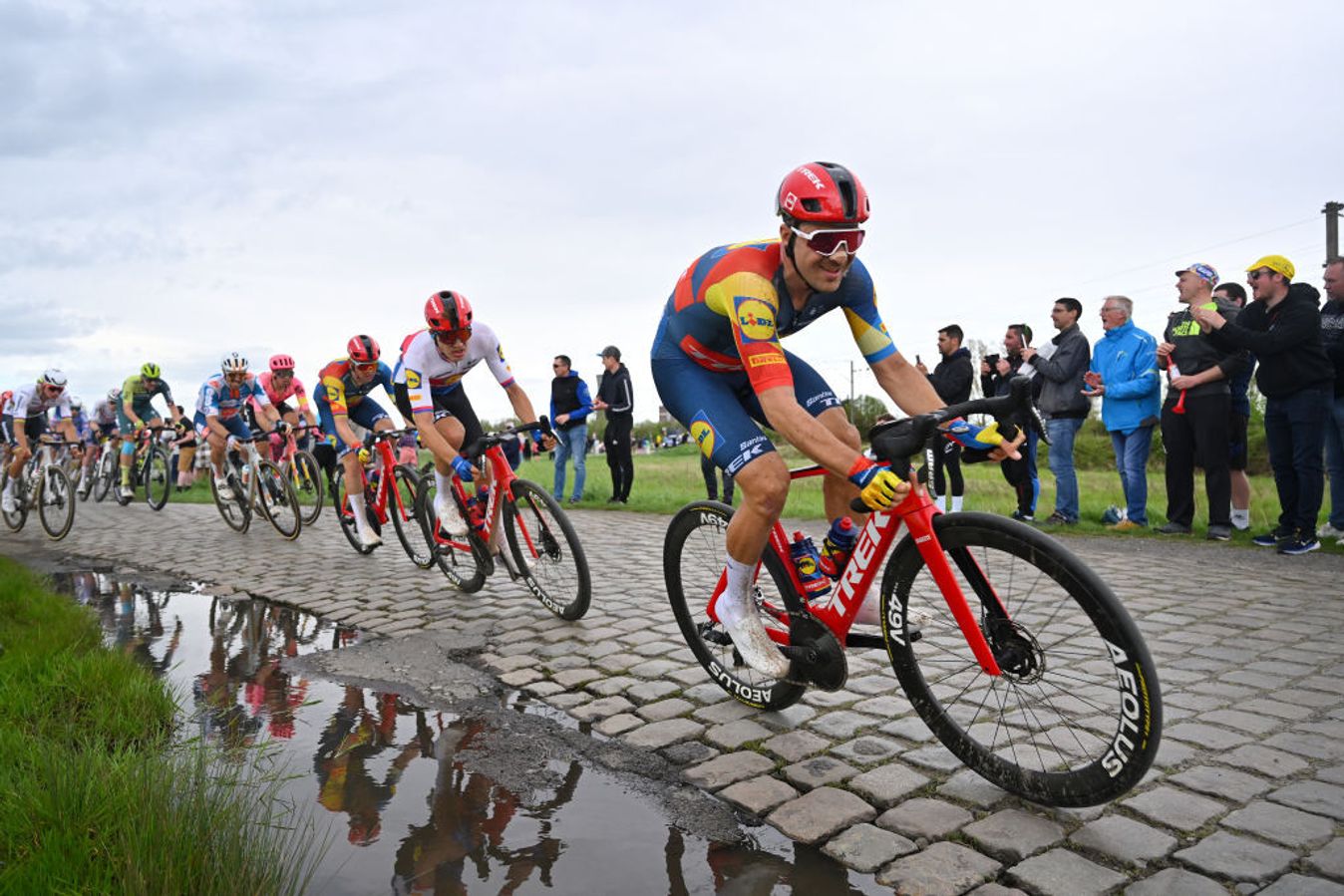
© Getty Images
Lidl-Trek were dominant in both races, but won neither
As well as the parallel rainbow jersey wins, there was another common thread between the men’s and women’s Roubaix, and that was the performances of the two Lidl-Trek teams. The two squads have been on similar trajectories this season: boosted by the new investment in the team, they’ve taken a step up in terms of their Classics prowess, and are both considered to be the main competitors to the top Classics team in their respective pelotons. Where Kopecky and Van der Poel have sometimes mirrored each other, so too have Mads Pedersen, Elisa Longo Borghini and Elisa Balsamo.
Although Lidl-Trek were dominant in both races, they couldn't quite beat the favourites, finishing with second for Elisa Balsamo and third for Mads Pedersen. Their stories were similar. Both sides of the team placed two riders in the decisive selections of the day and once again proved their strength, but they were ultimately beaten by better riders. On reflection, both Balsamo and Pedersen were satisfied with their results, which likely also speaks of the positive ethos within the team during this broadly successful Classics period. Missing the win in Roubaix shouldn’t detract from what they’ve achieved in the past few weeks.
What we can conclude is that Lidl-Trek in both forms should firmly be considered one of the very best Classics teams in the world, and a force to be reckoned with in the biggest races of the season.
4. It’s not always about the last person standing
Billed as the ‘Hell of the North,’ Paris-Roubaix is a race that conjures up images of battered athletes crawling their way to the line in dribs and drabs, as they complete their sacrifice and haul their bodies to the most iconic concrete theatre in the sport. The romantic notion of the Queen of the Classics is one of individual suffering, with a lone attacker winning more often than not, and with chase groups strung out in a splintered mess behind.
This is how Lizzie Deignan won in 2021 and it is how Fabian Cancellara claimed his second title in 2010. But other than Mathieu van der Poel’s exhibition on Sunday, this past weekend’s editions of Paris-Roubaix were not raced in the same buccaneering spirit of ‘last person standing.’ Behind Van der Poel, groups of three and nine riders contested small sprints amongst themselves to decide the standings of the top 20.
Things were even more organised in the women's race. The winner came in as part of a group of six, and bar Ellen van Dijk (Lidl-Trek) dropping off the pace in the front group on the final lap of the velodrome, the next rider to come to the finish alone was way down in 25th place. A 10-rider group contested positions 7-16th, whilst a further four-rider group rounded out the top 20.
It is up for discussion as to why this year’s races were less selective than one might imagine. Perhaps a longer route for the women, or one that included the Trouée d'Arenberg might have forced more gaps to appear. While in the men’s race, it could be argued that the chasing group were effectively neutralised by Alpecin-Deceuninck’s Jasper Philipsen and Gianni Vermeersch, thereby nullifying the racing. But whatever the reason, this year’s Paris-Roubaix proves that the Queen of the Classics does not always chew riders up and spit them out in a pit of isolated suffering.
5. Soudal Quick-Step is dead, long live Alpecin-Deceuninck

© Getty Images
This team is on fire: Mathieu van der Poel and Jasper Philipsen on the podium of Paris Roubaix
In March, the men’s professional peloton completed the fastest edition of Milan-San Remo, with the winner averaging 46.1kph. A month later, the men raced the fastest edition of the Tour of Flanders, with the winner averaging 44.5kph and just a week later, they completed Paris-Roubaix at a fastest-ever average speed of 47.8kph.
On the top step of each podium was an Alpecin-Deceuninck rider. And, to cap off the most wonderful spring for the Belgian team, Milan-San Remo winner Jasper Philipsen finished second behind the Flanders-Roubaix double-winning Mathieu van der Poel on Sunday. It was the icing on the cake for a team that not long ago raced as a second division outfit.
When Alpecin-Deceuninck's roster of primarily cyclo-cross riders first began the transition to the road towards the end of the 2010s, Quick-Step were the team of the moment in the Classics.
Fast forward to 2024 and not only have Alpecin taken Quick-Step’s former co-title sponsor in Deceuninck, but they have also taken their crown as the Kings of the Classics. Once a team built merely to serve Van der Poel’s fledgling road ambitions, Alpecin-Deceuninck demonstrated in Sunday’s Paris-Roubaix that they are now so much more than this.
Van der Poel was the one lifting the biggest cobblestone of all at the end of the day, but his victory was as much thanks to the work of his teammates behind as it was to his sparkling form. His dependable domestiques laid the groundwork for a searing pace over 100km before the Dutchman eventually took his leave, whilst Philipsen and Gianni Vermeersch performed above and beyond to close down every attack behind Van der Poel in the finale.
Sunday was a masterclass by the greatest one-day team that cycling has seen since Mapei in the 1990s. The less said about Soudal Quick-Step, meanwhile, the better at the moment.
6. Vos might never add a cobblestone to her collection
This may be a bold assertion to make, but Saturday underlined that there is a very real possibility that Marianne Vos could retire without winning Paris-Roubaix. She’s still contracted to be riding next year and possibly beyond but this weekend was likely her best chance since this race began, with the Dutchwoman in top form this spring having won two Belgian Classics. She did make it into the decisive move but couldn’t shake faster riders and was beaten in the sprint for the win, settling for fourth. Despite her protestations before the race that she doesn’t really see Roubaix as a gap in her staggering palmarès, it would be nice for Vos to retire with a win at the Queen of the Classics alongside her Flanders win, Tour de France yellow jersey and three world titles.
In light of Saturday’s fourth place, the question must be asked: what scenario does Vos need to be in to win in the velodrome? And this is where it gets tricky. The 36-year-old is not a rider who is suited to a solo attack, so she needs to go with a selective group, but also make sure the group doesn’t contain any faster finishers. And can she actually do that? Could she drop riders like Lotte Kopecky and Elisa Balsamo next year? Honestly, we’re not sure. Even the G.O.A.T. has limits, and the specific demands of Paris-Roubaix – long, attritional, no punchy climbs – could go against her chances of winning here.
7. The next French winner will probably be a woman
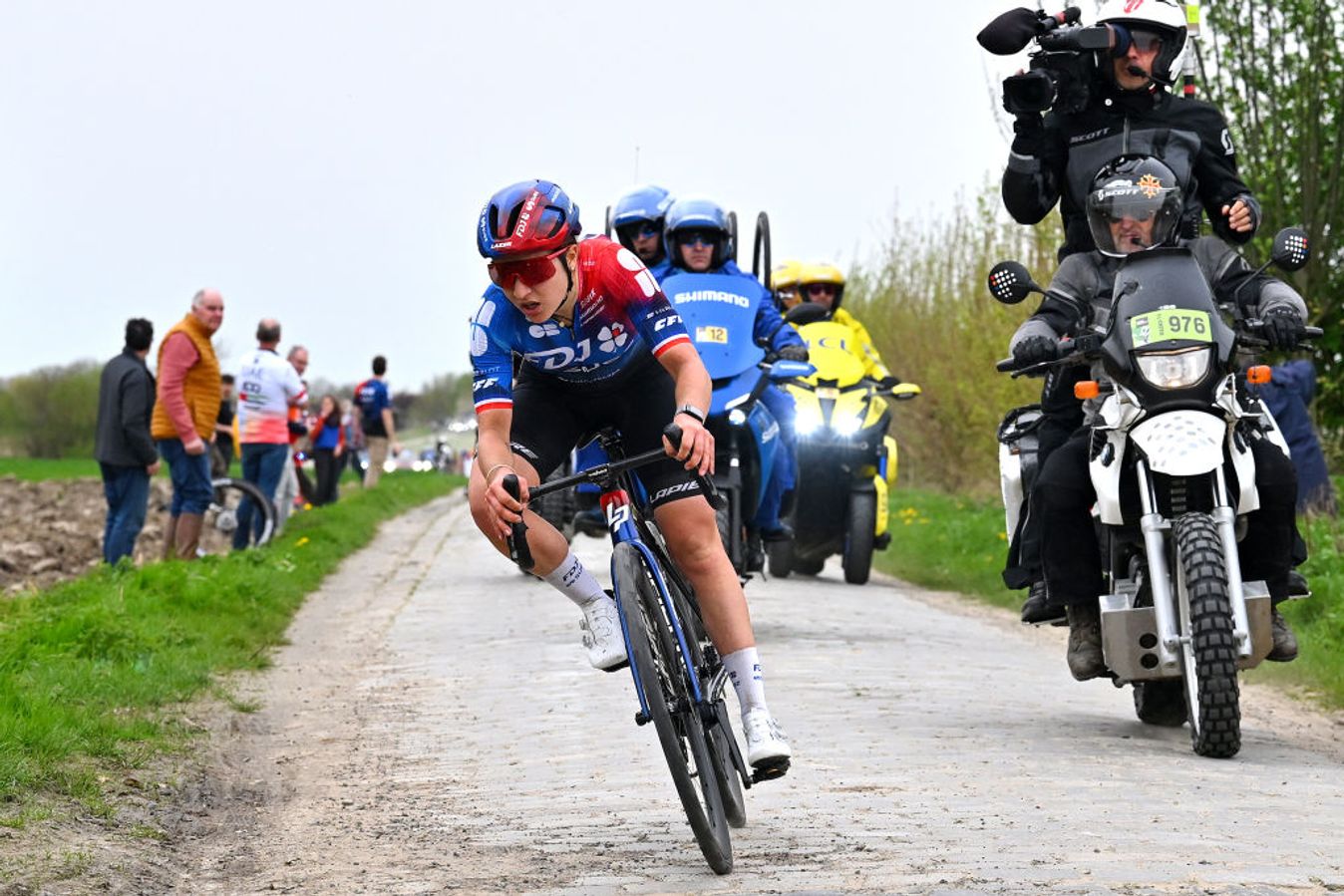
© Getty Images
Frenchwoman Jade Wiel put in a meaningful solo attack in Saturday's race
Whenever these big French races come around, there’s always chatter about when the last French winner was, because in the case of Paris-Roubaix and the Tour de France, the answer is quite a long time ago. As such, in the French media particularly, you’ll always find speculation about why that is, who the next winner may be, and how long the cycling-loving French public will have to wait. After witnessing the two races over the weekend, our assertion is that the next French winner in the André Pétieux velodrome will be a woman.
In the men’s race, the French riders were never really near the front in the key moments, and the nation’s best finisher was Christophe Laporte (Visma-Lease a Bike) in 25th. That’s below countries like Estonia, New Zealand and Kazakhstan. Stefan Küng and Laurence Pithie represented Groupama-FDJ, the French team, in the top 10, but unfortunately, that doesn’t make them French. In the women’s race, however, it was a different story for the home nation. They didn’t podium but there were three French women in the top 15 and French squad FDJ-SUEZ was one of the most active and well-represented teams in the whole race. It was Amber Kraak, a Dutchwoman, who the team placed highest, but she was joined by Victoire Berteau (Cofidis) and teammate Marie Le Net in the top 10, whilst Gladys Verhulst-Wild finished 12th.
Looking to the future, Christophe Laporte may indeed be a Roubaix winner, but the French talent is deeper in the women’s peloton, with Le Net, Verhulst-Wild and Jade Wiel all looking like future stars on the cobbles.
8. Cycling remains best when watched from the roadside
In a spring of domineering performances in the Classics, be it Tadej Pogačar at Strade Bianche, Mathieu van der Poel at the E3 Saxo Classic, Mathieu van der Poel at the Tour of Flanders or…. you get our drift. In a spring of such immense displays of power, Sunday’s men’s Paris-Roubaix was perhaps one race too far for some of the watching public at home.
As Mathieu van der Poel crossed the line in the Roubaix velodrome, social media was awash with awe and anguish in equal measure. To some, the men’s race was boring. It was another afternoon of watching Van der Poel ride clear without much difficulty, as his opponents messed around behind and refused to put together a coordinated chase. In many ways, these critics are right. It is not hard to see why many struggled to be entertained by a scene that we have seen plenty of times before — albeit not in such grandiose fashion at the Queen of the Classics.
On the roadside, however, Sunday’s race was a spectacle, full of expectation, excitement and exaltation. Team GCN were on the ground, and witnessed the buzzing atmosphere at the roadside. At the Forest of Arenberg, fans draped over barriers and rope. In some places, they even perched in bushes to get a glimpse of the stars as they thundered through this natural echo chamber.
Just minutes later, the same legion of fans would take to the highway and rush to the Roubaix Velodrome, but not before a roadside stop. As fans thundered north on the A23, Van der Poel appeared on the right alone, attacking on the Orchies sector of cobblestones and drawing the convoy of traffic to a standstill, with everyone desperate to catch another glimpse of the rainbow jersey.
Van der Poel’s victory might have been a tiring affair for many on the television, but for fans out on the course, it was another marvel of afternoon entertainment. Bike racing rarely disappoints when viewed up close.
For more racing analysis and commentary, visit our dedicated Racing page on the GCN website.
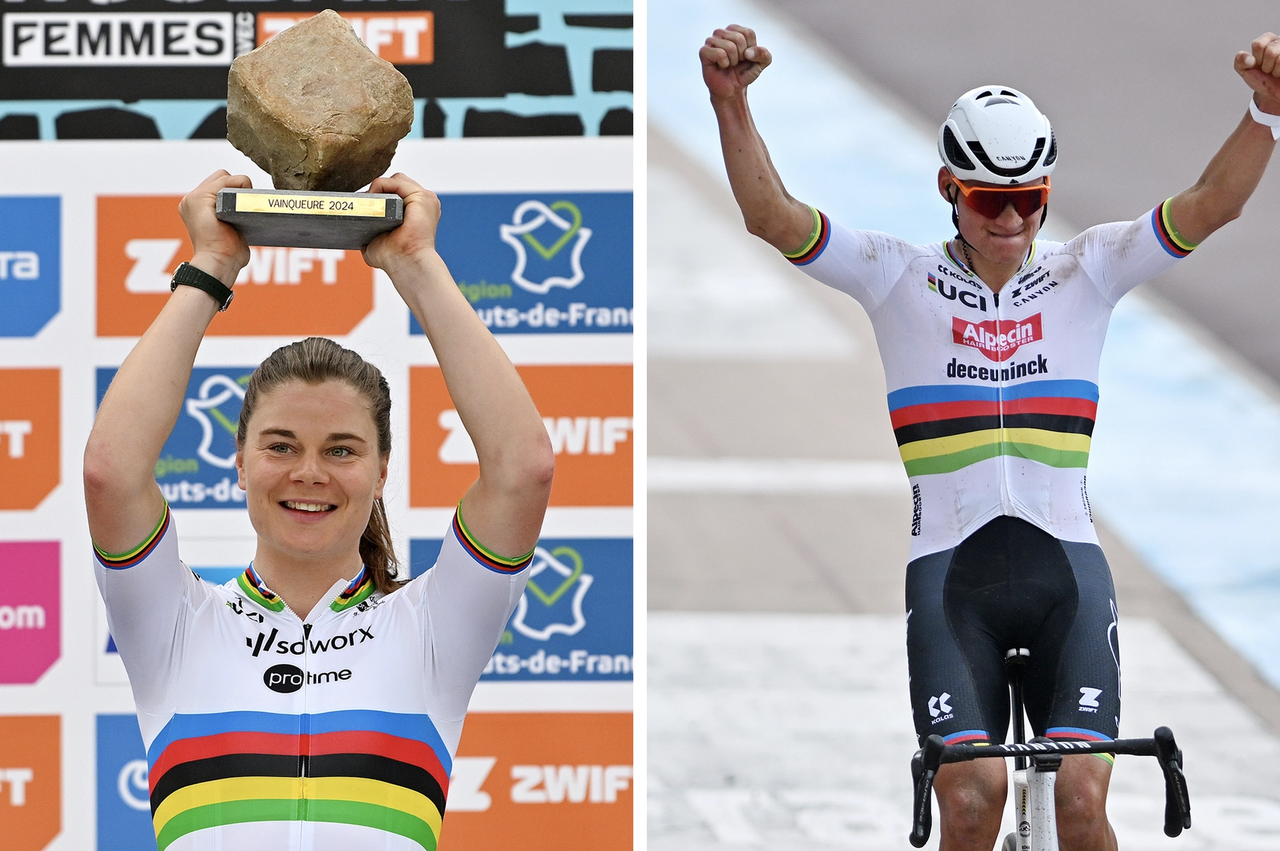














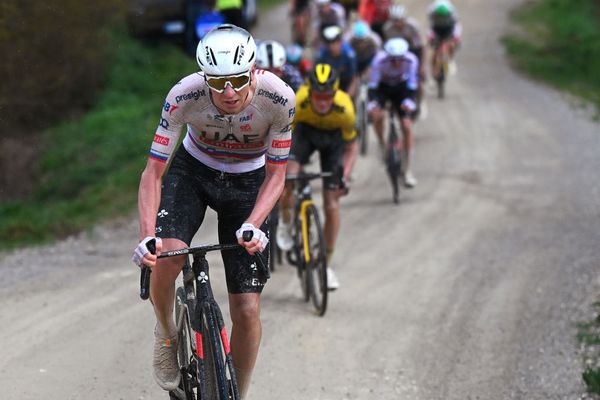
.jpg?w=600&auto=format)
